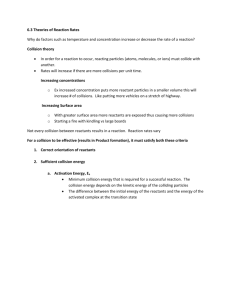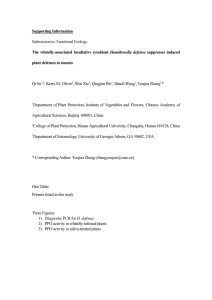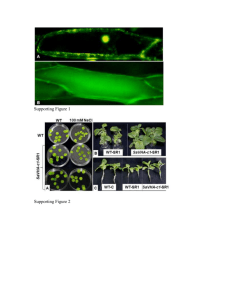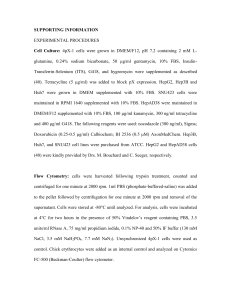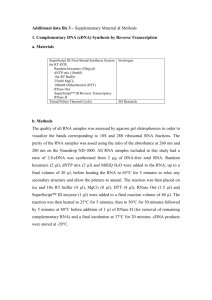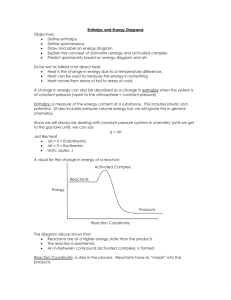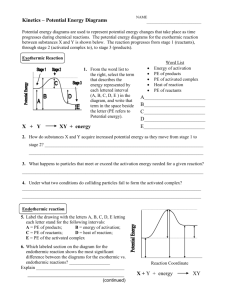Representing a Reaction with a Potential Energy Diagram
advertisement
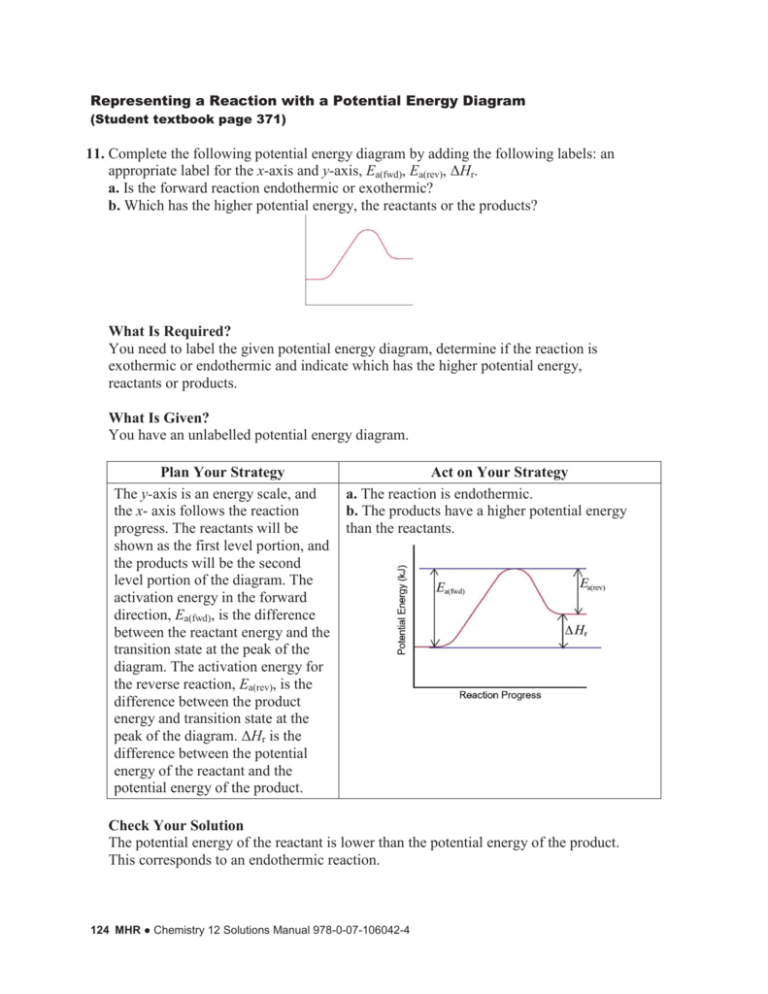
Representing a Reaction with a Potential Energy Diagram (Student textbook page 371) 11. Complete the following potential energy diagram by adding the following labels: an appropriate label for the x-axis and y-axis, Ea(fwd), Ea(rev), ΔHr. a. Is the forward reaction endothermic or exothermic? b. Which has the higher potential energy, the reactants or the products? What Is Required? You need to label the given potential energy diagram, determine if the reaction is exothermic or endothermic and indicate which has the higher potential energy, reactants or products. What Is Given? You have an unlabelled potential energy diagram. Plan Your Strategy The y-axis is an energy scale, and the x- axis follows the reaction progress. The reactants will be shown as the first level portion, and the products will be the second level portion of the diagram. The activation energy in the forward direction, Ea(fwd), is the difference between the reactant energy and the transition state at the peak of the diagram. The activation energy for the reverse reaction, Ea(rev), is the difference between the product energy and transition state at the peak of the diagram. ΔHr is the difference between the potential energy of the reactant and the potential energy of the product. Act on Your Strategy a. The reaction is endothermic. b. The products have a higher potential energy than the reactants. Check Your Solution The potential energy of the reactant is lower than the potential energy of the product. This corresponds to an endothermic reaction. 124 MHR ● Chemistry 12 Solutions Manual 978-0-07-106042-4 12. Consider the following reaction: AB + C → AC + B ΔHr = +65 kJ, Ea(rev) = +34 kJ Draw and label a potential energy diagram for this reaction. Calculate and label Ea(fwd). What Is Required? You need to draw a potential energy diagram labelling the x-axis and y-axis, the transition state, and Ea(fwd). What Is Given? You know the balanced chemical equation for the reaction. You know the activation energy of the reverse reaction: Ea(rev) = +34 kJ You know the enthalpy change of the forward reaction ΔHr = +65 kJ Plan Your Strategy Use the formula DH r = Ea(fwd) - Ea(rev) to calculate Ea(fwd). Act on Your Strategy DH r = Ea(fwd) - Ea(rev) +65 kJ = Ea (fwd) - ( +34 kJ ) Ea ( fwd ) = +99 kJ Draw and label the potential energy diagram. Check Your Solution Since the sign of ΔHr is positive, the reaction is endothermic and the potential energy diagram shows the reactants at a lower energy than the products. Unit 3 Part B ● MHR 125 13. Consider the reaction below: C + D → CD Ea(fwd) = +61 kJ, Ea(rev) = +150 kJ Draw and label a potential energy diagram for this reaction. Calculate and label ΔHr. What Is Required? You need to draw and label a potential energy diagram for this reaction and calculate and label ΔHr. What Is Given? You know the activation energy of the forward reaction: Ea(fwd) = +61 kJ You know the activation energy of the reverse reaction: Ea(rev) = +150 kJ Plan Your Strategy Use the formula DH r = Ea(fwd) - Ea(rev) to calculate ΔHr. Act on Your Strategy DH r = Ea(fwd) - Ea(rev) = +61 kJ - ( +150 kJ ) = -89 kJ Draw and label the potential energy diagram. Ea(rev) is the energy difference between the transition state and the products (+150 kJ). ΔHr is the enthalpy of reaction between the reactants and the products (–89 kJ). Check Your Solution Since the sign of ΔHr is negative, the reaction is exothermic. The diagram correctly shows the potential energy of the product lower than the potential energy of the reactant. 126 MHR ● Chemistry 12 Solutions Manual 978-0-07-106042-4 14. Using the potential energy diagram below, estimate the values for Ea(fwd), Ea(rev), and ΔHr. Is the reaction endothermic or exothermic? What Is Required? You need to estimate the values for Ea(fwd), Ea(rev), and ΔHr based upon the given potential energy diagram and indicate if the reaction endothermic or exothermic. What Is Given? You have a potential energy diagram. Plan Your Strategy Refer to the scale on the y-axis and determine the difference in energy between the reactants and the transition state, Ea(fwd); the difference in energy between the products and the transition state, Ea(rev); and the difference between the energy of the reactants and products, ΔHr. Act on Your Strategy Estimated values for Ea(fwd), Ea(rev), and ΔHr are: Ea(fwd) = +42 kJ Ea(rev) = +67 kJ ΔHr = –25 kJ The reaction is exothermic. Check Your Solution Check to be certain that you have counted the correct number of divisions when determining the energies on the y-axis. Unit 3 Part B ● MHR 127 15. In the upper atmosphere, oxygen exists as O2(g), as ozone, O3(g), and as individual oxygen atoms, O(g). Ozone and atomic oxygen react to form two molecules of oxygen gas. The enthalpy change is –392 kJ and the activation energy is +19.0 kJ. Draw and label a potential energy diagram. Include a value for Ea(rev). What Is Required? You need to determine the value of Ea(rev) for a reaction and draw and label a potential energy diagram. What Is Given? You know the activation energy of the forward reaction: Ea(fwd) = +19 kJ You know the enthalpy change of the forward reaction: ΔHr = –392 kJ Plan Your Strategy Use the formula DH r = Ea(fwd) - Ea(rev) to determine Ea(rev). Act on Your Strategy DH r = Ea(fwd) - Ea(rev) –392 kJ = +19 kJ – Ea (rev) Ea ( rev ) = +411 kJ Draw and label a potential energy diagram. Check Your Solution Since the sign of ΔHr is negative, the reaction is exothermic. The diagram correctly shows the potential energy of the product lower than the potential energy of the reactant. 128 MHR ● Chemistry 12 Solutions Manual 978-0-07-106042-4 16. For a reaction, on an arbitrary scale, the potential energies are as follows: activated complex, +112 kJ; reactants, +36 kJ; products, +78 kJ. a. Determine the activation energy and the enthalpy change for the reaction. b. Draw a labelled potential energy diagram for the reaction, indicating the relative energies of the reactants, products, and activated complex. What Is Required? You need to determine the activation energy, Ea, and the enthalpy change, ΔHr, for the reaction. You need to draw a potential energy diagram for the reaction. What Is Given? You know the potential energies: activated complex, +112 kJ; reactants, +36 kJ; products, +78 kJ. Plan Your Strategy a. The activation energy is the difference between the potential energy of the activated complex and the potential energy of the reactants. The enthalpy change is the difference in potential energy between the products and reactants. Estimate the energy scale (y-axis) that will include the calculated differences in energy. b. Draw and label the potential energy diagram. Act on Your Strategy Ea = 112 kJ - 36 kJ = +76 kJ DH = 78 kJ - 36 kJ = +42 kJ Check Your Solution The sign of the enthalpy change is positive, and the diagram will show the potential energy of the reactants lower than the potential energy of the products. Unit 3 Part B ● MHR 129 17. Refer to the list of molar enthalpies of combustion for hydrocarbons in Table 5.4 (student textbook page 295). a. Write the balanced thermochemical equation for the combustion of methane gas, CH4(g). b. Draw a potential energy diagram that would reasonably represent this combustion reaction. Indicate the ΔHcomb and a molecular structure that could represent an activated complex in this potential energy diagram. What Is Required? You need to write the thermochemical equation for the combustion of methane and draw a reasonable energy profile diagram that could represent the process. Include a molecular structure that could represent an activated complex in the potential energy diagram. What Is Given? From Table 5.4, you know the molar enthalpy of combustion for methane: o = –890.8 kJ/mol DH comb The products for complete combustion are H2O(ℓ) and CO2(g). Plan Your Strategy a. Table 5.4 gives a negative value for the heat of combustion so the equation for the combustion reaction shows the heat term as a product. b. Draw and label potential energy diagram for the reaction including a molecular structure that could represent an activated complex. Act on Your Strategy CH4(g) + 2O2(g) → CO2(g) + 2H2O(ℓ) + 890.8 kJ The activated complex would show an unstable association of one CH4(g) molecule and O2(g) molecule with partial bonds. Check Your Solution The potential energy diagram should match the given information. An example of the burning of a hydrocarbon is given in the student text page 367. 130 MHR ● Chemistry 12 Solutions Manual 978-0-07-106042-4 18. When steam is passed over hot iron, a reaction occurs as shown below. 3Fe(s) + 4H2O(g) ¾¾ ® Fe3O4(s) + 4H2(g) ¬¾ ¾ ΔHr = –151.2 kJ The activation energy for the reverse reaction, Ea(rev), is +200.71 kJ. a. Calculate the activation energy for the forward reaction. b. Draw a labelled potential energy diagram showing the enthalpy change, and the activation energies for the forward and reverse reactions. What Is Required? You need to calculate the activation energy for a forward reaction. You need to draw a labelled potential energy diagram showing the enthalpy change, and the activation energies for the forward and reverse reactions. What Is Given? You know the enthalpy change of the forward reaction: ΔHr = –151.2 kJ/mol You know the activation energy of the reverse reaction: Ea(rev) = +200.71 kJ Plan Your Strategy a. Use the formula DH r = Ea(fwd) - Ea(rev) to calculate Ea(fwd). Act on Your Strategy DH r = Ea(fwd) - Ea(rev) -151.2 kJ = Ea (fwd) - ( +200.71 kJ ) Ea (fwd) = +49.5 kJ b. Draw a labelled energy profile diagram. Diagram shows that the reactants have higher potential energy than the products. The activated complex, having the highest potential energy, is positioned between the reactants and products. Check Your Solution Check that the labels are all included. The reaction is exothermic so the potential energy of the products should be lower than the potential energy of the reactants. Unit 3 Part B ● MHR 131 19. The decomposition of dinitrogen tetroxide(g), N2O4(g), to nitrogen dioxide, NO2(g), is a reversible reaction. The activation energy for the decomposition reaction is +58.6 kJ. N2O4(g) + 55.3 kJ → 2NO2(g) Draw a potential energy diagram for the reaction showing appropriate labels for both axes, Ea(fwd), Ea(rev), and ΔHr. What Is Required? You must calculate the activation energy for the reverse reaction and draw a potential energy diagram for the reaction showing appropriate labels for both axes, Ea(fwd), Ea(rev), and ΔHr. What Is Given? You know the enthalpy change of the forward reaction: ΔHr = +55.3 kJ/mol You know the activation energy of the forward reaction: Ea(fwd) = +55.3 kJ Plan Your Strategy Use the formula DH r = Ea(fwd) - Ea(rev) to calculate Ea(rev). Act on Your Strategy DH r = Ea(fwd) - Ea(rev) +55.3 kJ = + 58.6 - Ea (rev) Ea (rev) = +3.3 kJ Draw a labelled energy profile diagram. Diagram shows that the reactants have lower potential energy than the products. The activated complex, having the highest potential energy, is positioned between the reactants and products. Check Your Solution Check that the labels are all included. The reaction is endothermic with a small activation energy for the reverse reaction. The potential energy of the products should be higher than the potential energy of the reactants. 132 MHR ● Chemistry 12 Solutions Manual 978-0-07-106042-4 20. What is Ea(fwd) for the reaction represented below that has Ea(rev) = +235 kJ? A + 2CD + 85 kJ → G What Is Required? You need to calculate the activation energy of the forward reaction, Ea(fwd). What Is Given? You know the enthalpy change of the forward reaction: ΔHr = +85 kJ You know the activation energy of the reverse reaction: Ea(rev) = +235 kJ Plan Your Strategy Use the formula DH r = Ea(fwd) - Ea(rev) to calculate Ea(fwd). Act on Your Strategy DH r = Ea(fwd) - Ea(rev) +85 kJ = Ea(fwd) - (+235 kJ) Ea(fwd) = +320 kJ Check Your Solution Check that the given values have been substituted correctly with the proper sign. Unit 3 Part B ● MHR 133
